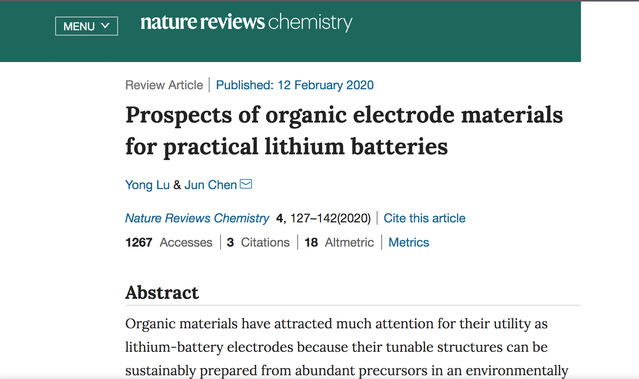Prof. Jun Chen’s Team Published an Article on Nature’s Series Analyzing Prospects of Organic Electrode Materials for Practical Lithium Batteries

The CAS academician and Nankai University’s Prof. Jun Chen’s team have been recently invited by the editorial board of “Nature Reviews Chemistry”, a journal of Nature’s series, to publish a review article entitled “Prospects of organic electrode materials for practical lithium batteries”. The article deeply illustrates the structural characteristics, the action mechanism, the structure-effect relationship of organic electrode materials and focuses on the analysis of their actual status and application prospects. The article helps academics and industries to fully understand the practical application potential and the problem-solving of organic electrode materials. It is expected to stimulate more application-oriented research work and promote the future commercialization of organic batteries. The article’s first author is Dr. Yong Lu and the corresponding author is Prof. Jun Chen.
Lithium ion batteries are currently widely used in various portable electronic devices, proving its advantages in the informatization, mobilization, intelligentization and socialization of human society, and they are expected to be applied in a large scale in the areas like electro-mobile and smart power grids. However, the cathode materials of commercial lithium-ion batteries are mainly inorganic transition metal oxides and phosphates, and most of the transition metal resources are non-renewable. Battery recycling technology is complex and costly, and it may face difficult problems such as resource shortage in a long run. Therefore, the development of recyclable electrode materials has become an academic frontier and a major demand in the field of batteries.
Organic materials have attracted much attention for their utility as lithium-battery electrodes because their tunable structures can be sustainably prepared from abundant precursors in an environmentally friendly way. The review article of Prof. Chen’s team provides insights on the future development of organic electrode materials. It points out that the organic electrode materials have an adjustable structure, so according to different molecular structures and reaction potentials, organic materials can be used as positive or negative active materials in practical applications. The article first discusses various key properties of the organic electrode material itself, including energy density, power density, cycle life, gravimetric density, electronic conductivity and other relevant parameters, such as energy efficiency, cost, resource availability, and thermal / chemical stability. Among them, energy density, power density and cycle life are the basic electrochemical properties of materials. These properties are affected by the gravimetric density and conductivity of materials. Other factors such as stability and price are also to be considered. Then the article analyzes the effect of the unit surface load of the active material in the electrode and the amount of electrolyte on the performance of the whole battery from the perspective of actual application. Finally, the research team used the software to simulate the actual lithium battery system with organic materials as the positive or negative electrodes and evaluated the performance (such as overall energy density, power density) and price and other parameters of the relevant battery system. The results show that n-type organic cathode materials, especially carbonyl compounds, have good practical application prospects.
The article concludes that future research should focus on the following aspects. (1) It is necessary to pay attention to the conductivity and density of organic electrode materials, which is closely related to the performance and cost of actual batteries; (2) The performance of organic electrode materials should be tested in the full battery as close to the actual application conditions as possible; (3) The development of commercially available lithium-containing negative electrodes or the development of lithiated organic positive electrodes is conducive to the construction of battery systems similar to the actual lithium-ion batteries. Moreover, how to produce high-performance organic electrode materials on a large scale and at low cost also still needs to be explored.
Link to the article: https://www.nature.com/articles/s41570-020-0160-9
(Reported by Chao Ma, Translated by Yuchen Shi, Edited by Davide Francolino and JianjingYun)









